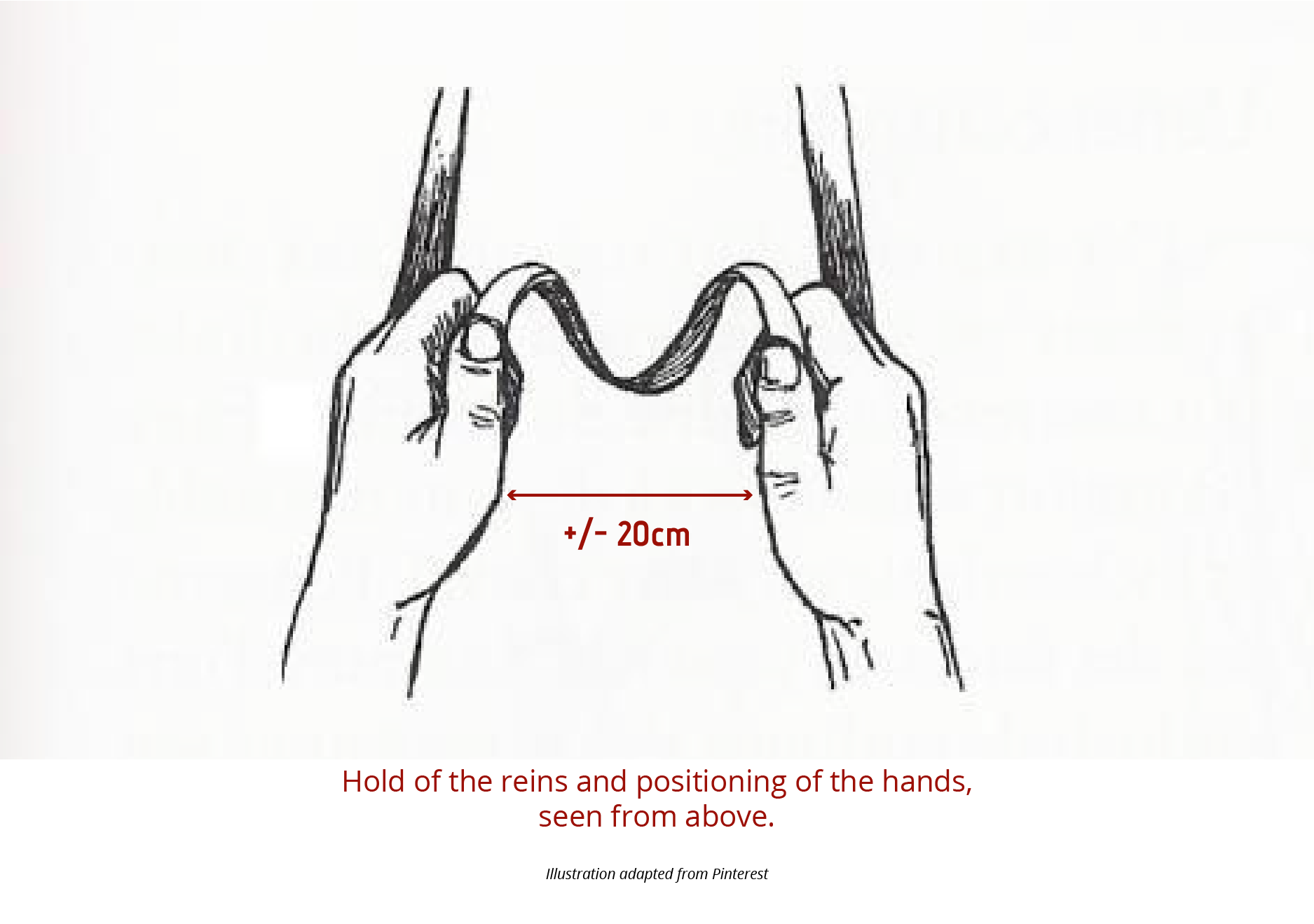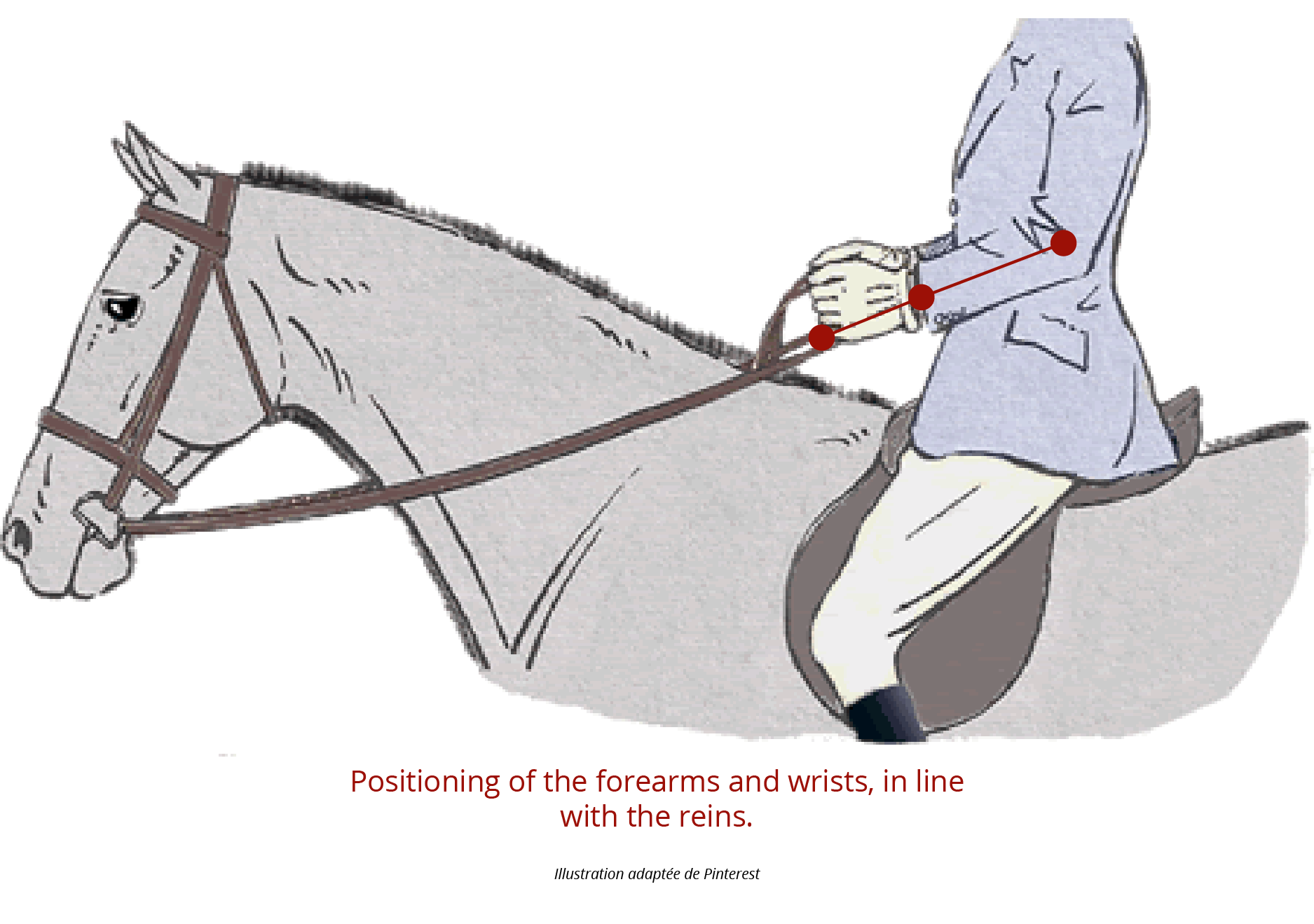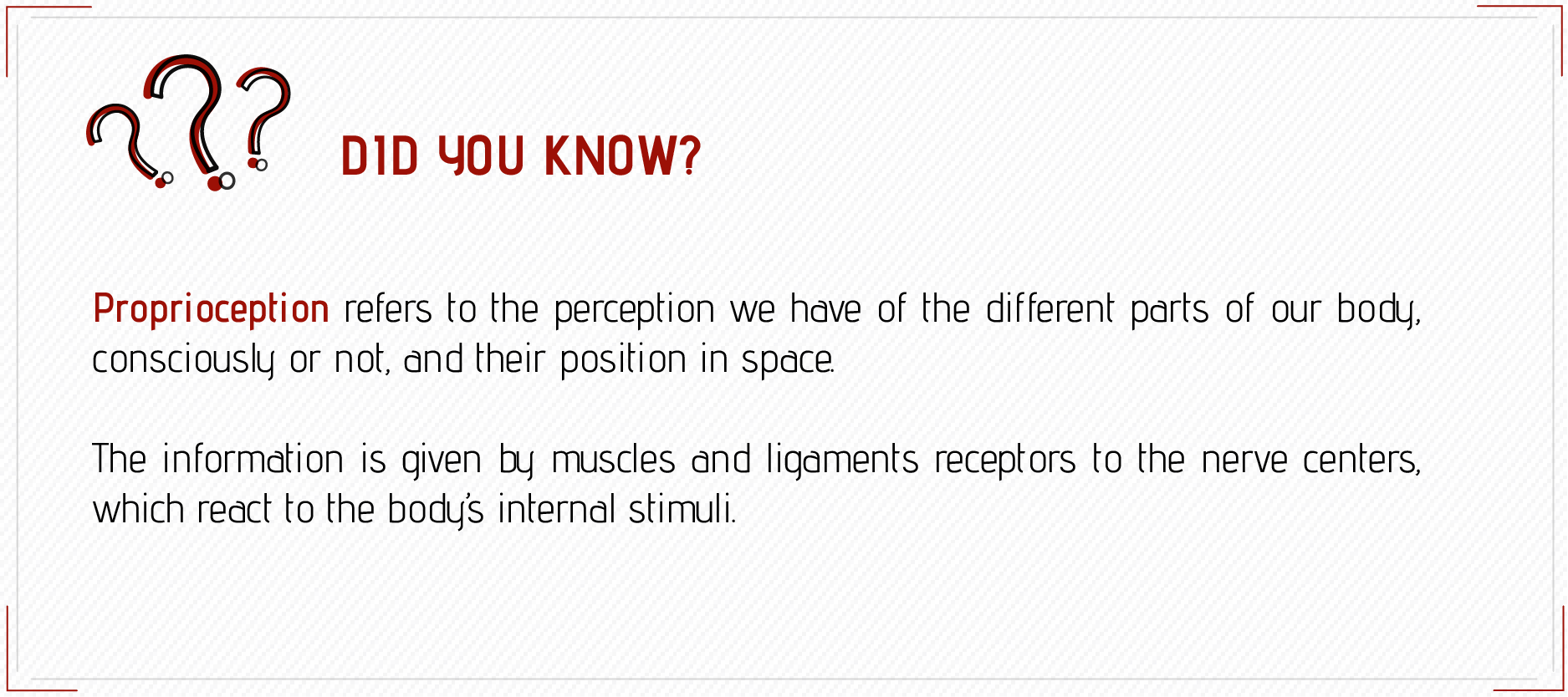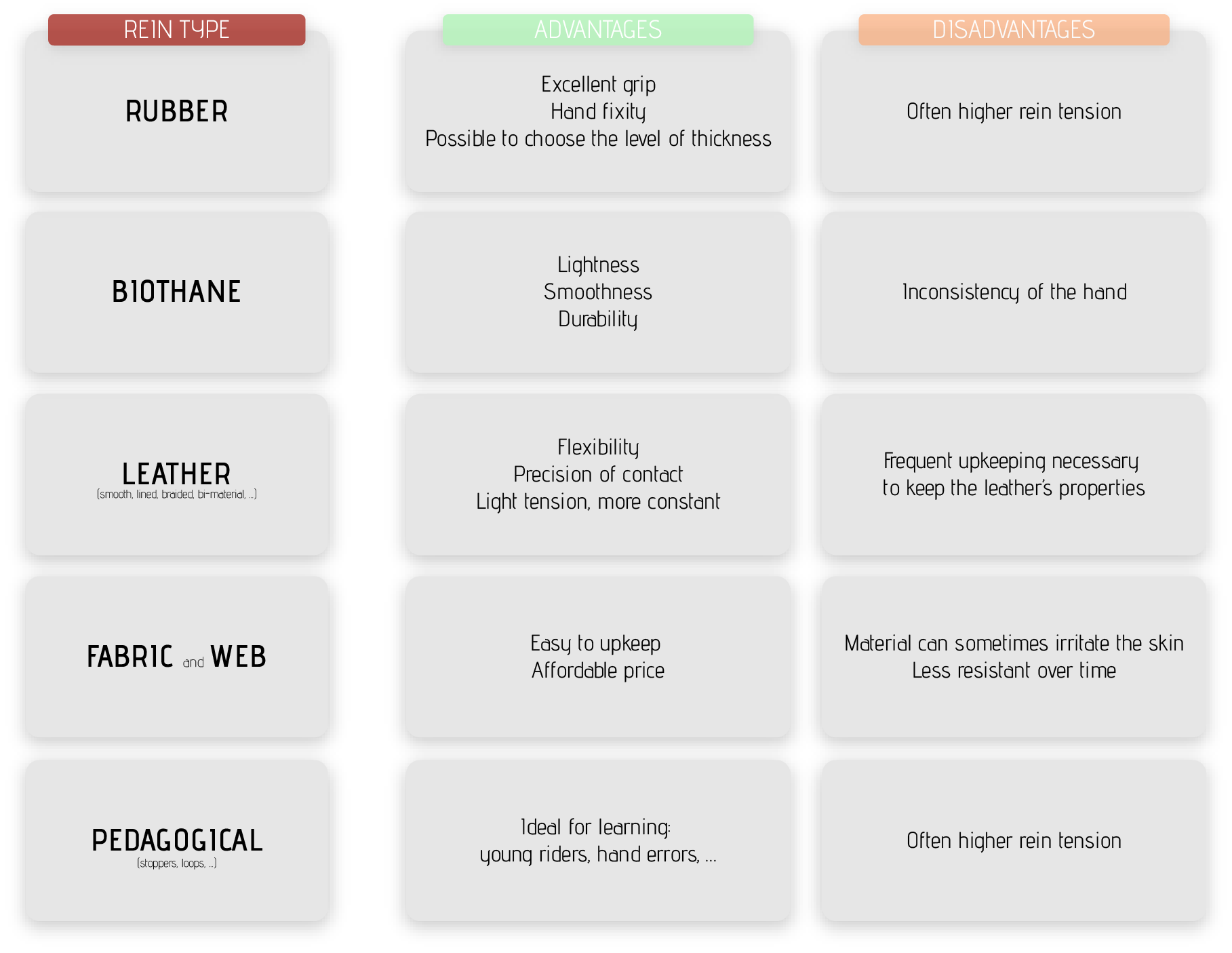Only US$ 500 left to enjoy free shipping!
No products
Only US$ 500 left to enjoy free shipping!
No products
Reins allow the rider to communicate with his horse to give him indications, such as of direction and movement. In this article, review the basics of their proper use, and learn more about the different types of reins and their effects on your horse.
As there are different types of girths or bridles, there are a multitude of possibilities regarding the reins sold on the market. Whether it is the materials used, the design or the sensations sought by the rider. However, when making this choice, we don’t always take into account the impact reins can have on the horse…
Every rider, from the very fist riding lessons, has learned how to use his reins. How to hold them correctly and at the right length, how to position his hands, obtain a constant contact...
The reins, through the bit, allow for an almost direct action on the horse’s mouth. They are part of the “artificial aids”, in opposition to the “natural aids” such as body weight, legs or voice.



Note, however, that these “rules” are a generalization. Indeed, there are different ways to hold reins: French style, English style, … For example, if you compare two high-level riders, regardless of the discipline, they won’t hold their reins the same way. In reality, these “rules” have to be adapted to each rider, based on his way of riding and the discipline he practices.
The hands can act, resist and give on the reins. The goal is to obtain a permanent and smooth contact with the horse’s mouth, while being able to act more firmly if necessary.
Tension can be defined as the force resulting from the actions of the rider’s hands and the resistance of the horse’s mouth. It can be impacted by multiple variables such as the level of both rider and horse, the gait, and even the type of reins or bits.

According to Paul McGreevy, veterinarian and ethologist, the tension applied by the rider on the reins should be 2 Newtons, which is about 200 grams. It’s more or less equivalent to the reins’ weight.
From the very first riding lessons, riders are taught to maintain a light tension on the reins, and to give indications using the reins’ weight. However, some studies have revealed that the tension really exerted by the rider is often greater than he believes. Indeed, the tension on the reins perceived by the rider is a subconscious feeling related to proprioception.

Thus, many studies show significant differences between the tension perceived by the rider and reality. If proprioception is one of the “causes”, there are many others; which can come from the rider as well as from the horse, whether it is related to biomechanics, the gait, level of training, movements asked…
Contrarily to what one might think, it is not always the inexperienced rider who applies higher tension on the reins. Indeed, studies have shown that novice riders tend to apply very little tension, and maintain it irregularly compared to experienced riders.
A beginner rider would thus have a “basis” contact of 1 Newton on average, i.e. approximatively 100 grams. An experienced rider would in comparison have an average contact between 5 and 10 Newton (which means almost 1 kilo at most).
According to Hilary M.Clayton, veterinarian and searcher in equestrian biomechanics, "the reins are used to apply a signal, allowing control or modification of the horse's speed and direction of movement."
The rider therefore applies a bilateral tension (i.e., on both reins) to request gait deceleration. If he asks for a change of direction, this tension will then be unilateral.
During mounted work, several studies have shown significant variations in tension depending on the gait. The higher the gait, the higher the tension tends to be. Tension at walk is often the lightest: between 130 and 760 grams on average. It is however much more important at canter, sometimes reaching up to 62.5 Newtons, i.e., more than 6 kilos!
The same goes for the recorded tensions peaks, whether during the cyclic variations of the different gaits or while transitioning. Thus, high tension peaks often occur when the rider asks for a downward transition, such as canter-walk, but also during upward transitions.

Broadly speaking, the tension applied by the rider is rarely symmetrical and constant. This brings us back to the principle of proprioception. Each rider being different, he will not have the same motor capacities or the same sensitivity as another. Thus, studies have shown that riders with more developed motor skills tend to apply less tension, and in a more consistent manner, making it easier for them to obtain an “ideal” contact on the reins.

Indeed, too much tension will also have a negative impact of the horse’s learning, which is most often achieved using negative reinforcement. It means that the rider applies a stimulus to the horse, expecting a specific response, and releases it when the horse has responded correctly. It is therefore essential to have the right tension depending on the request, but also to know how to release it at the right time.
Over the last few years, there has been a significant increase regarding the number of rein models available on the market. Whether it is the materials used, the thickness, the discipline recommended, there is nowadays a multitude of choices.
Different studies have shown that the reins most used by riders are the rubber ones, for several reasons:
Riders tend to prefer these reins as they feel they have better contact and greater control.
Even though these reins can be beneficial to improve some riders’ hand steadiness, they have a less precise action than some other rein types. In fact, according to the data recorded from these studies, rubber reins are the ones on which the rider would put the greater tension.
Biothane® reins are quite similar, in their design, to rubber reins. Mainly used for the practice of Endurance, there are thinner and lighter than rubber reins, but also stronger than leather ones.
Biothane being a flexible material, the rider’s grip is often softer on this type of reins. This allows him to have more discreet hand actions.
There are different types of leather reins, whether it is regarding thickness, leather grain or braiding. Most often, the type of leather reins chosen by the rider depends on the discipline he practices.
Smooth leather reins, for example, are mainly used by Dressage riders. They place them on the snaffle bit when using a bridle. Indeed, these reins are very flexible which allows the rider to gain greater precision in his requests, as well as a very fine contact with his horse’s mouth. Some training aids, such as German draw reins, also often are smooth leather reins.
On the other hand, braided leather or bi-material reins are more popular amongst Hunter riders. They offer additional grip compared to smooth leather reins but are thinner and more flexible than rubber reins.
Generally speaking, leather reins are judged in studies as the “softest” ones; that is, those on which riders apply the least tension, and where the tension is the most constant.
Easier to use than leather ones, fabric or web reins indeed require less up-keeping. As they often have stoppers, they are frequently used in equestrian centers as a teaching tool to facilitate riders’ learning.
They are however less resistant than leather or rubber reins, and can irritate the skin if the fabric used doesn’t have specific technical properties (such as anti-heating for example).
These types of reins are often made out of leather, rubber or fabric. The particularity is that they have either stoppers or loops.
In both cases, there reins are often recommended for riders who are still learning, or letting their reins lengthen over jumps or cross-country for example. Be careful, however, with these reins, of the tension applied by the rider on his horse’s mouth.
Reins are therefore an essential part of the rider’s equipment, who must choose them carefully and according to multiple criteria such as the discipline practiced, his level and his way of riding.

However, having the right reins is not enough. It is important to pay attention to the tension you apply on them, and thus indirectly on your horse’s mouth. Developing your proprioception is also a good way to improve the contact you have on the reins, to make it as ideal as possible.
Illustrations adapted from Pinterest.
J. W. Christensen, T. L. Zharkikh, A. Antoine & J. Malmkvist, “Rein tension acceptance in young horses in a voluntary test situation” Equine Vet. J., vol. 43, no. 2, 2011.
S. Kuhnke, L. Dumbell, M. Gauly, J. L. Johnson, K. McDonald & U. König von Borstel, “A comparison of rein tension of the rider’s dominant and non-dominant hand and the influence of the horse’s laterality,” Comp. Exerc. Physiol., vol. 7, no. 2, 2010.
H. Randle, A. Abbey & L. Button, “The effect of different rein types on the rein tension applied when taking up a ‘medium contact’”, Journal of Veterinary Behavior, vol. 6, Issue 5, 2011.
M. O’Neil, “The effect of rein type and bit type on rein tension in the ridden horse”, University of Plymouth Institutional Repository (PEARL), 2018.